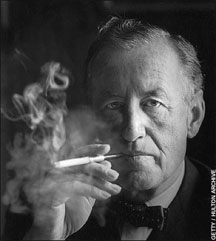From Empire With Love
by Peyvand Khorsandi
07-Jul-2008
James Bond is arguably the mother of all on-screen celebrations of white, European masculinity. More than two billion people – two fifths of the world's population – have watched a 007 film. Only Tarzan or Indiana Jones might rival his stature. For Your Eyes Only: Ian Fleming And James Bond [1] – the exhibition currently running at London's Imperial War Museum – sets out to outline the relationship between the fictional secret agent and the man who created him, Ian Fleming.
Fleming (pictured) was born to a wealthy Scottish banking family. He went to the elite school Eton and then the military training academy Sandhurst. His father Valentine Fleming, an aristocratic MP, was killed in 1917, serving in the same unit as Winston Churchill in World War I. Peter, Ian's older brother, was handed the mantle of family patriarch.
A journalist and established travel writer, Peter's derring-do in foreign climes in part inspired his younger brother to take to fiction. Ian needed a refuge from his sibling's towering shadow and found this in the character he'd created, James Bond.
Peter recommended his publisher Jonathan Cape publish the first Bond novel in 1953, something Cape did with reluctance. Another 11 novels were written before Fleming died in 1964 – a window one cannot help but notice -- in which the sun truly set on the British Empire. Bond, you can be forgiven for thinking became a fictional substitute for Empire, a national hero who could – and did – take over the world, or at least its imagination.
But historical context is not what this homage to writer and character is about – nor is it is about the gadgetry that many Bond aficionados will be hoping to see.
Sure, there is the gun from Goldfinger; one of the yellow space helmets from Moonraker; a cello pierced by a bullet from The Living Daylights; flick-knife shoes from From Russia With Love; a spear-gun from Thunderball; a transparent "nuclear" bomb from The World Is Not Enough; a golden gun with bullets marked "007"; a wing-mirror dart-gun from Live And Let Die; the heart-transplant unit used for smuggling diamonds in The Living Daylights; the overcoat worn by Sean Connery in Dr No; Daniel Craig's bloodied shirt from Casino Royale; and a portrait of Halle Berry in an orange bikini in Die Another Day.
There's also much to read up on – it is, after all, a biographical display: here's Fleming in Switzerland, at school, here he is with Ms X or Ms Y, his recipe for scrambled eggs – there are truly Bond facts galore.
But all this is no solace for museum-goers there for more interactive fun. The exhibition problem is not its lack of gadgets, but that they are not Bond gadgets. A virtual roulette table turns at the press of a button, sending a ball landing on a number which then triggers a Bond fact in audio. The two children I saw playing with this machine, however, were less interested in hearing what the roulette table had to say about Bond, than in spinning it around and around.
There is a signed letter to Fleming from Joseph Stalin refusing him the audience he had asked for one while in Russia, among family albums and numerous postcards, letters and loads of manuscripts. Then you reach a glass display with international editions of the novels.
Here, the exhibition loses its steam. Who wants to see a wall of international first editions?
And you can forget about any dissection of the appeal of James Bond as the embodiment of British imperialism too – eminently civilised exterior, licence to kill without compunction – is not touched on.
Tony Blair comes to mind. Aptly, we learn that Bond attended Fettes, the same school Britain's former prime minister – though poor Bond today would probably end up poorly equipped in Afghanistan or Iraq on the basis of dodgy information taken from the internet and end up in an Al-Qaeda video.
What struck me most at the exhibition was an oil painting featured on the cover of Live And Let Die depicting a restrained and half-naked 007 looking on powerlessly as two or three black men held a Barbarella-style blond captive – a sure indicator that Bond is the product of a racist colonial mindset.
The exhibition is intended to celebrate a hundred years since Ian Fleming’s birth and to coincide with the publication of the Sebastian Faulks-penned novel Devil May Care – in which Bond visits Iran. Yet although we might be on the brink of seeing America's first black president sworn in, we are probably a century away from seeing a black James Bond.
Visit Peyvand Khorsandi's Soul Bean Cafe [2]
| Recently by Peyvand Khorsandi | Comments | Date |
|---|---|---|
| Fantasy fatwa | 5 | Jul 01, 2012 |
| Living Dead | 1 | Apr 19, 2012 |
| Not one for breakfast | 2 | Mar 06, 2012 |


